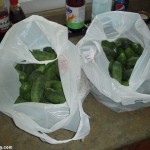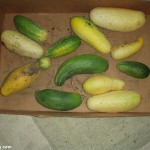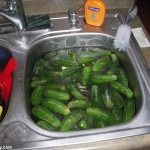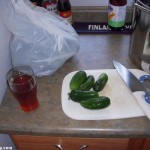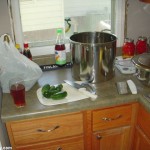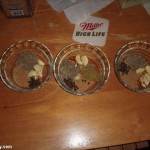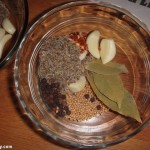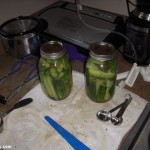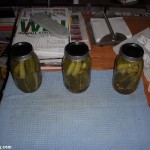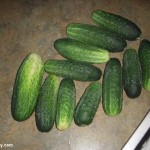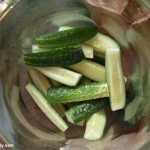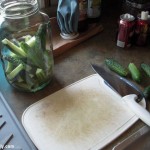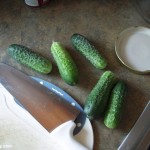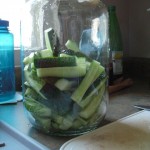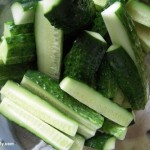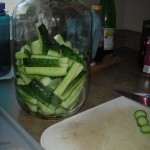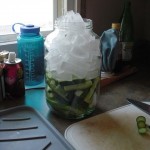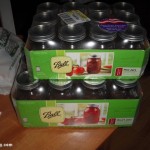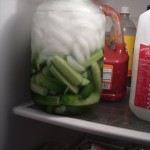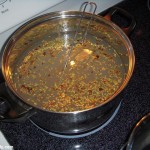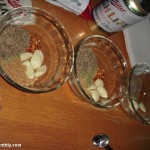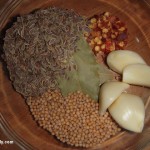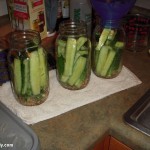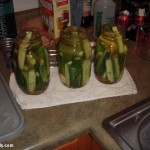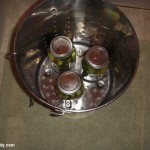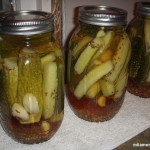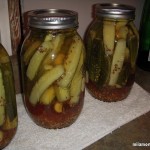At first I thought that I was going to process all the pickles that I bought at the downtown Farmer’s Market into v2 & v3 pickles. But while processing the ~7lbs of cucumbers for v2 & v3, I thought that I would go a different route and try to make some brine fermented pickles. Years and years ago back in Michigan I tried to make fermented pickles, and the experiment was an utter failure. So now that I’ve got a little bit more canning and homebrewing experience under my belt, I thought that I would give fermented pickles another try. Before this fermented experiment begun, I stopped by the library to pick up a copy of The Joy of Pickling by Linda Ziedrich(not the revised edition), to try and get a base recipe down, as well as some tips and tricks.
Continue reading
Tag: pickles
Dill Pickles – v2 & v3 – September 2010
Since the downtown farmer’s market isn’t going to be around for very much longer, I though that I should take advantage of the situation and make some more pickles before the season is over.
After doing a quick walk around to gauge the prices, I finally found a vendor that was selling 1 1/2 pint containers of pickling cucumbers for $2.00 each. Wanting to get the price even lower, I offer them $15 for 10 containers. We eventually settled on $18 for 10 containers (a $2 total discount). I have a feeling that if I had waited until noon (when the market stops) instead of when I was there at 11am, I could have gotten them for $15.
But I still got a hell of a good deal, since the two bags of cucumbers ended up weighing ~15 lbs, so at ~$1.20 lb it was still a great deal. Later on I didn’t realize how much ~15 lbs of cucumbers were until I started to process them. After getting through the first ~7 lb bag, I decided to make the pickles two different ways, fermented/brined and hot processed vinegar pickling (like v1.) Below you’ll see the recipes that I used for versions 2 and 3 of the vinegar pickles. The brined pickles (version 4) will be getting their own separate post.
Version 2.0
Brine:
(note: less vinegar & more water compared to v1)
- 3.5 cups vinegar
- 4.5 cups water
- 2 TB pickling spice mix
- 1/4 cup white sugar
- 1/2 cup canning salt
Bring Mixture to a boil, then simmer for 15 mins.
Per quart jar add:
(note: added black peppercorns & celery seeds compared to v1)
- 2 bay leaves
- 4 cloves garlic
- 1/4 tsp red pepper flakes
- 1/2 tsp whole black peppercorns
- 3/4 tsp celery seed
- 2 tsp mustard seed
- 3 tsp Dill seed
Process 15 mins in a boiling water canner
Yield: 3 quart jars
Version 3.0
I had some remaining brine from v2, so I just strained it. I then added 1.5 cups vinegar, 2.5 cups water, 4 TB white sugar, 1/4 cup of salt. This addition was just a little bit short. So I topped off the jars with a mixture of 1/4 cup vinegar & 1/4 cup water.
Brine:
(note: less vinegar & more water, also removed the pickling spice compared to v1 & v2)
- 3 cups vinegar
- 5 cups water
- 1/4 cup white sugar
- 1/2 cup canning salt
Bring Mixture to a boil, then simmer for 15 mins.
Per quart jar add:
(note: increased the red pepper flakes to 1/2 tsp, and increased the celery seed to 1 tsp compared to v2)
- 2 bay leaves
- 4 cloves garlic
- 1/2 tsp red pepper flakes
- 1/2 tsp whole black peppercorns
- 1 tsp celery seed
- 2 tsp mustard seed
- 3 tsp Dill seed
Process 15 mins in a boiling water canner
Yield: 4 quart jars
Side Notes:
1) Add the celery seeds after removing all the air from the jar with the food saver attachment. If you don’t, you’ll end up with a lot of seeds inside the attachment, instead of inside the jar.
2) One of the v3 jars doesn’t have any garlic inside, since I used up the rest of the garlic for the other three jars in v3. This was a one time problem, since I then ended up purchasing a 3 lb jug of peeled garlic.
3) Don’t over fill the jars, since it looks like with v3, I had a bit of a boil over in the canner kettle. Since the water was a little bit green after processing.
Dill Pickles – v1 – 07/14/2010
And now for the final canning recipe, even though I made these a couple of days before the carrots and beans. I kind of went in a totally different route, in that I didn’t soak the pickle spears in a brine before canning. Since I’ve noticed that all the brine pre-soak does, is make your final product extra salty. So somewhere online, I saw a bunch of tips on soaking the sliced cucumbers in an ice-bath to increase the final pickles “crispness”. But seeing how I only soaked them for an hour before processing, I really don’t know if it added much to the recipe, since most recipes were suggesting a 4 to 5 hour ice bath before processing.
So on to rest of the recipe:
Brine
- 1 qt (4 cups) vinegar
- 1 qt (4 cups) water
- 2 TB pickling mix
- 1/4 cup white sugar
- 1/2 cup canning salt
Bring Mixture to a boil, then simmer for 15 mins.
Per quart jar add:
- 2 bay leaves
- 4 cloves garlic
- 1/4 tsp red pepper flakes
- 2 tsp mustard seed
- 3 tsp Dill seed
Remember to make sure and use to plastic knife to get out the air bubbles. I also use the mason jar attachment for the food saver to get all the bubbles out.
Yield: 3 quart jars
Process 15 mins in a boiling water canner
Side Notes:
1) Since these pickles were the first canning experiment of the year, I forgot a bunch of steps that I would normally do. The big one being to get the air bubbles out the jar before processing. I was lucky that all the jars sealed after processing. But I guess this is what I get for the first canning session of the year.
2) The brine amount in the recipe ended up being the prefect amount for three quart jars, with no waste.
3) Since I forgot to grow fresh dill this year to add to the pickles, I went with dill seed instead.
What time is it? Bloody Mary time!
Every once in a while I get a craving for Bloody Mary’s, the last fix was during the Forth of July this year. I don’t know if it’s the spices in a Bloody Mary, or the vitamins in the tomato juice. But when I want one, I’ve got to have one.
Since Bloody Mary’s are made with tomato juice, V8 or Clamato I automatically place the drink in the exotic drink category (even though tomatoes are technically a fruit and not a vegetable). But other then that horticultural peculiarity called the tomato, I still find the drink a little bit hard to understand. But slowly I’m coming to grips with the whole concept. Continue reading
